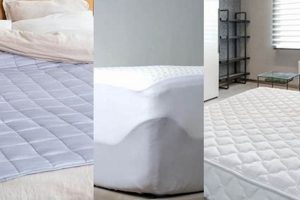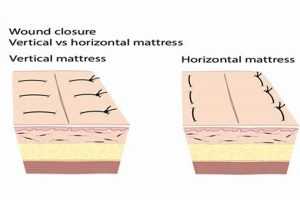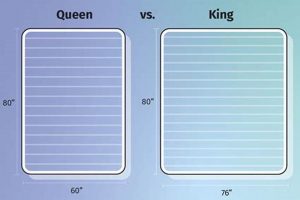Mattress toppers are supplementary layers designed to enhance the comfort and support of an existing mattress. These additions typically consist of materials like memory foam, latex, or fiberfill, and are available in varying thicknesses. Common options include those measuring two inches and three inches, each offering a distinct feel and level of impact on sleep quality.
The selection of a mattress topper can influence spinal alignment, pressure point relief, and temperature regulation during sleep. Historically, mattress toppers were primarily utilized to extend the lifespan of an older mattress. Today, they also serve as a cost-effective method to customize the firmness and overall sleeping experience without replacing the entire mattress.
The subsequent sections will examine the specific characteristics, advantages, and potential drawbacks associated with choosing between the two common thickness options, providing insight to facilitate an informed purchasing decision based on individual needs and preferences.
Guidance on Selecting a Mattress Topper by Thickness
When considering a mattress topper to enhance sleep quality, the thickness plays a critical role in its performance. The following guidance addresses key factors in choosing between different sizes.
Tip 1: Assess Individual Support Needs: A thinner topper, such as the two-inch variety, may suffice for individuals seeking subtle comfort adjustments or minor pressure relief. In contrast, a three-inch option typically provides greater cushioning and support, particularly beneficial for those with existing back pain or a preference for a softer sleep surface.
Tip 2: Evaluate Mattress Condition: If the underlying mattress exhibits significant sagging or unevenness, a thicker topper may be necessary to compensate for these deficiencies. The three-inch topper can offer a more substantial layer of correction compared to its thinner counterpart.
Tip 3: Consider Body Weight: Individuals with a higher body weight generally benefit from a thicker topper. The increased density provides greater support and prevents premature compression, thereby maintaining the desired level of comfort over time.
Tip 4: Account for Sleeping Position: Side sleepers often require more cushioning to alleviate pressure on the shoulders and hips. A three-inch topper is generally more suitable for side sleepers, while back or stomach sleepers may find a two-inch topper adequate.
Tip 5: Review Material Density: Regardless of thickness, the density of the topper material influences its firmness and longevity. Higher density materials tend to provide better support and resist compression, making them a worthwhile consideration for both options.
Tip 6: Factor in Heat Retention: Thicker toppers, particularly those made of memory foam, may retain more heat. If temperature regulation is a concern, explore options with cooling technologies or consider materials like latex, which tend to be more breathable.
The appropriate thickness is contingent on specific requirements, considering factors such as body weight, sleeping position, and the condition of the existing mattress. A careful evaluation of these elements will facilitate a selection that optimizes sleep comfort and support.
The concluding section will summarize the advantages and disadvantages of each mattress topper thickness, assisting in the final decision-making process.
1. Thickness Impact
The thickness of a mattress topper significantly influences its performance characteristics, differentiating the two-inch and three-inch options. Thickness directly correlates with the degree of contouring and support provided. A three-inch topper, possessing greater material volume, conforms more closely to the body’s shape, potentially alleviating pressure points more effectively than its two-inch counterpart. For instance, a side sleeper with pronounced pressure on the hips and shoulders may experience superior relief with a thicker topper due to its increased capacity for weight distribution.
The thickness factor also affects the overall height of the sleeping surface. This can be a relevant consideration for individuals with mobility limitations or those who prefer a specific bed height for ease of access. Furthermore, the density of the material used within each topper thickness is critical. A high-density two-inch topper may offer comparable support to a lower-density three-inch topper, underscoring the need to evaluate material composition alongside thickness measurements. As an example, a two-inch latex topper could provide firmer support than a three-inch memory foam topper.
In summary, the ‘thickness impact’ is a crucial determinant of the comfort and support characteristics of a mattress topper. While a thicker topper often provides enhanced pressure relief and contouring, the material density and overall bed height must also be considered. The optimal thickness depends on individual preferences, body weight, and specific support requirements. Failure to consider the interplay between thickness and material properties may result in a suboptimal sleeping experience.
2. Pressure Relief
Pressure relief, a critical component in mattress topper design, directly correlates with the thickness of the topper. Thicker toppers, such as the three-inch variety, generally offer enhanced pressure relief compared to thinner two-inch models. This stems from their greater capacity to conform to the body’s contours, distributing weight more evenly across the sleeping surface. This redistribution minimizes concentrated pressure on specific areas, notably the hips, shoulders, and knees, which are common pressure points during sleep. For instance, an individual experiencing hip pain might find a three-inch memory foam topper more effective in alleviating discomfort due to its increased cushioning and conforming properties.
The effectiveness of pressure relief is also contingent on the material composition of the topper. High-density memory foam or latex, regardless of thickness, tend to provide superior pressure relief compared to lower-density materials like fiberfill. A two-inch high-density memory foam topper could, in some cases, offer comparable or even better pressure relief than a three-inch low-density foam topper. Furthermore, factors such as sleeping position and body weight influence the required level of pressure relief. Side sleepers typically benefit more from enhanced pressure relief due to the concentration of weight on a smaller surface area, while heavier individuals may require a thicker or denser topper to prevent bottoming out and maintain adequate pressure distribution.
In summary, while thickness is a primary factor in determining pressure relief effectiveness, it is not the sole determinant. Material density, sleeping position, and body weight all play significant roles. Understanding these interconnected factors allows for a more informed selection of a mattress topper, optimizing pressure relief and promoting a more comfortable and restorative sleep experience. A misjudgment in selecting the appropriate level of pressure relief can lead to continued discomfort, disrupted sleep, and potentially exacerbate existing musculoskeletal issues.
3. Support Level
The support level provided by a mattress topper is intrinsically linked to its thickness, with the distinction between two-inch and three-inch options directly impacting spinal alignment and overall sleep posture. A thicker topper, such as the three-inch variant, generally offers a higher degree of support due to its increased ability to distribute weight evenly and prevent excessive sinking into the mattress. This enhanced support is particularly crucial for individuals with back pain or those who require a firmer sleeping surface to maintain proper spinal curvature. Conversely, a two-inch topper may provide sufficient support for individuals of lighter weight or those who prefer a softer feel, but it may lack the necessary reinforcement for heavier individuals or those with pronounced postural needs. For example, an individual with a body mass index (BMI) exceeding 30 may find that a three-inch topper provides more adequate support, preventing the development of pressure points and promoting a more neutral spinal alignment.
The material composition of the topper further modulates the relationship between thickness and support level. A two-inch topper constructed from high-density latex can deliver a more supportive feel than a three-inch topper made of low-density memory foam. The density of the material dictates its resistance to compression, thereby influencing the degree of support provided. Practical applications of this understanding involve carefully assessing both the thickness and density of the topper in relation to individual weight, sleeping position, and pre-existing musculoskeletal conditions. For example, a stomach sleeper might prefer a firmer, two-inch latex topper to prevent excessive spinal curvature, whereas a side sleeper might opt for a three-inch memory foam topper to cushion pressure points while maintaining adequate spinal alignment.
In summary, the support level of a mattress topper is a function of both its thickness and material density. While a three-inch topper generally offers greater support than a two-inch option, the specific material properties and individual needs must be carefully considered. Challenges in selecting the appropriate support level often arise from a lack of awareness regarding the interplay between these factors. Understanding the relationship between thickness, material density, and individual requirements is essential for optimizing sleep quality and mitigating potential musculoskeletal issues. Ignoring the support level when choosing a mattress topper may lead to inadequate spinal alignment, discomfort, and ultimately, a compromised sleep experience.
4. Motion Isolation
Motion isolation, the ability of a mattress or topper to absorb movement and prevent its transfer across the surface, is a significant factor for couples or individuals sharing a bed. The thickness of a mattress topper, specifically whether it is two inches or three inches, can influence its effectiveness in minimizing motion disturbance during sleep.
- Material Density and Absorption
Denser materials, such as memory foam or latex, tend to exhibit superior motion isolation properties compared to less dense materials. Within these materials, a three-inch topper generally provides a greater buffer against movement transfer than a two-inch topper, due to the increased volume of material available to absorb kinetic energy. For example, if one partner shifts positions during the night, a thicker memory foam topper will likely contain the motion more effectively, reducing the likelihood of disturbing the other partner’s sleep.
- Thickness as a Dampening Factor
The additional thickness of a three-inch topper serves as a dampening layer, effectively reducing the propagation of movement across the mattress surface. This is particularly beneficial for individuals who are sensitive to movement or who share a bed with a restless sleeper. A thinner, two-inch topper may still provide some motion isolation, but its capacity to absorb and dissipate movement is inherently limited by its reduced volume. Consider the analogy of soundproofing: a thicker barrier generally absorbs more sound, similar to how a thicker topper absorbs more motion.
- Impact on Sleep Quality
Effective motion isolation directly contributes to improved sleep quality, particularly for co-sleeping individuals. By minimizing disturbances caused by partner movement, both individuals are more likely to experience uninterrupted sleep cycles, leading to enhanced rest and overall well-being. The choice between a two-inch and three-inch topper should, therefore, consider the sensitivity of each individual to movement and their respective sleep patterns. For example, if one partner is a light sleeper, the additional motion isolation provided by a three-inch topper may be a worthwhile investment.
- Limitations and Material Considerations
While thickness plays a crucial role in motion isolation, the material composition of the topper remains a significant factor. A two-inch topper made of high-density memory foam may outperform a three-inch topper constructed from a less dense material in terms of motion isolation. Consequently, a comprehensive assessment should consider both the thickness and density of the material to optimize motion isolation performance. Furthermore, the underlying mattress also influences the overall effectiveness of motion isolation, with a supportive and stable mattress base contributing to enhanced motion absorption.
In conclusion, the thickness of a mattress topper, specifically in the context of two-inch versus three-inch options, directly influences its ability to isolate motion. While a three-inch topper generally offers superior motion isolation due to its increased volume and dampening effect, the material density and the characteristics of the underlying mattress must also be considered to achieve optimal performance. Selecting the appropriate topper thickness, in conjunction with appropriate materials, contributes significantly to undisturbed sleep and enhanced overall rest quality.
5. Cost Efficiency
The economic implications of choosing between a two-inch and three-inch mattress topper manifest in both the initial purchase price and the long-term value derived from the product. Generally, a two-inch mattress topper will present a lower upfront cost compared to its three-inch counterpart. This differential stems directly from the reduced material usage in the thinner model. However, a superficial focus on initial cost overlooks the potential for increased long-term expenditure. For example, if a two-inch topper fails to provide adequate support or pressure relief, necessitating premature replacement, the accumulated cost may exceed that of a more durable and effective three-inch option.
The durability and longevity of each topper thickness are critical components of cost efficiency. A three-inch topper, assuming comparable material quality, may exhibit greater resistance to compression and degradation over time, thereby extending its usable lifespan. This prolonged lifespan translates to reduced replacement frequency and, consequently, lower overall expenditure. Conversely, a two-inch topper, particularly if subjected to significant weight or pressure, may compress rapidly, requiring replacement sooner than its thicker alternative. Material composition also influences the cost-efficiency equation. A two-inch topper made of high-density, durable materials may offer a superior value proposition compared to a three-inch topper constructed from lower-quality, less resilient materials.
Ultimately, a holistic assessment of cost efficiency necessitates a balanced consideration of upfront cost, expected lifespan, and performance characteristics. While the initial price of a two-inch mattress topper may appear attractive, the potential for premature replacement or inadequate performance may negate any perceived savings. The decision-making process should incorporate a thorough evaluation of individual needs, sleeping habits, and budget constraints to determine which thickness provides the optimal balance between cost and value. Disregarding these factors can lead to a selection that is ultimately more expensive in the long run, undermining the intended goal of cost-effectiveness.
6. Temperature Regulation
Temperature regulation is a critical consideration in mattress topper selection, as it directly impacts sleep comfort and overall rest quality. The thickness of a mattress topper, specifically the choice between two inches and three inches, can significantly influence heat retention and breathability, thereby affecting the sleeping environment’s temperature.
- Material Density and Airflow
Denser materials, commonly found in thicker mattress toppers, tend to restrict airflow and retain more heat. A three-inch memory foam topper, for example, may conform closely to the body, reducing ventilation and potentially causing overheating. Conversely, a two-inch topper, particularly one made of more breathable materials such as latex or open-cell memory foam, allows for better air circulation, mitigating heat buildup. The density of the material, irrespective of thickness, plays a vital role in determining the topper’s thermal properties.
- Heat Dissipation Capacity
The capacity of a mattress topper to dissipate heat is influenced by its thickness and composition. Thicker toppers, with their increased volume, may take longer to cool down after heat buildup. This can be problematic for individuals prone to night sweats or those living in warmer climates. A two-inch topper, with its reduced mass, typically cools down more quickly, providing a more temperature-neutral sleeping surface. However, the material’s inherent properties also dictate its heat dissipation characteristics; for example, gel-infused memory foam is designed to dissipate heat more effectively than traditional memory foam, regardless of thickness.
- Impact of Topper Thickness on Mattress Breathability
A thicker topper can impede the breathability of the underlying mattress. By adding a three-inch layer, the topper may restrict airflow through the mattress, exacerbating heat retention issues. This is especially relevant for mattresses that are already prone to overheating. A two-inch topper, by contrast, has a lesser impact on mattress breathability, allowing for better ventilation and temperature regulation. The choice between a two-inch and three-inch topper should, therefore, consider the thermal properties of the existing mattress.
- Considerations for Different Climates and Individual Needs
The ideal topper thickness for temperature regulation depends on the climate and individual physiological factors. In warmer climates, a thinner, more breathable topper is generally preferable to prevent overheating. Individuals who tend to sleep hot may also benefit from a two-inch topper made of cooling materials. Conversely, in colder climates, a thicker topper may provide added insulation and warmth, but caution should be exercised to avoid excessive heat retention. Personal preferences and thermal comfort thresholds should be carefully considered when selecting a mattress topper.
In summary, the relationship between temperature regulation and mattress topper thickness is complex and multifaceted. While a three-inch topper may offer enhanced comfort and support, it can also exacerbate heat retention issues. A two-inch topper generally promotes better airflow and temperature regulation, but may compromise on support and pressure relief. The optimal choice depends on a careful consideration of material properties, climate, individual needs, and the thermal characteristics of the underlying mattress. Neglecting to account for these factors can result in a sleeping environment that is either too hot or too cold, negatively impacting sleep quality and overall well-being.
Frequently Asked Questions
The following addresses common inquiries regarding the selection of mattress toppers based on thickness.
Question 1: What are the primary differences in performance between a two-inch and a three-inch mattress topper?
The primary differences reside in the degree of pressure relief, support, and motion isolation provided. A three-inch topper generally offers enhanced pressure relief and support due to increased material volume, while a two-inch topper may provide adequate comfort with potentially better temperature regulation.
Question 2: Does topper thickness correlate directly with firmness?
Thickness alone does not solely determine firmness. Material density plays a crucial role. A high-density two-inch topper may feel firmer than a low-density three-inch topper.
Question 3: Is a thicker topper always the better option for individuals with back pain?
Not necessarily. The ideal thickness depends on the individual’s weight, sleeping position, and the underlying mattress. A three-inch topper may provide more cushioning, but proper spinal alignment is paramount. A two-inch topper with appropriate support may be more suitable in some cases.
Question 4: How does topper thickness affect temperature regulation?
Thicker toppers generally retain more heat due to reduced airflow. A two-inch topper tends to be more breathable, making it a potentially better choice for individuals who sleep hot.
Question 5: What is the expected lifespan of a two-inch versus a three-inch mattress topper?
Assuming comparable material quality, a three-inch topper may exhibit greater longevity due to its increased resistance to compression. However, lifespan is also influenced by usage patterns and maintenance.
Question 6: Are there specific sleeping positions that benefit more from one thickness over the other?
Side sleepers often benefit from the enhanced pressure relief offered by a three-inch topper, while back and stomach sleepers may find a two-inch topper adequate, provided it offers sufficient support.
In summary, optimal topper thickness depends on individual needs and preferences. A thorough assessment of factors such as weight, sleeping position, temperature sensitivity, and budget is essential for making an informed decision.
The subsequent section will provide a concluding summary, reinforcing the critical considerations in selecting a mattress topper.
Concluding Assessment
The preceding analysis has delineated the critical distinctions between two-inch and three-inch mattress toppers, emphasizing the interplay of thickness, material composition, and individual needs. A thinner topper offers advantages in cost-effectiveness and temperature regulation, while a thicker option generally provides superior pressure relief, support, and motion isolation. The optimal selection hinges on a comprehensive evaluation of factors such as body weight, sleeping position, pre-existing musculoskeletal conditions, and budgetary constraints. A superficial consideration of any single factor may result in a suboptimal outcome, compromising sleep quality and long-term value.
Therefore, a judicious approach to mattress topper selection necessitates a thorough understanding of personal requirements and a careful assessment of available options. The information provided herein serves as a foundation for informed decision-making, empowering individuals to prioritize their specific needs and ultimately enhance their sleep experience. Continued diligence in evaluating evolving product offerings and adapting selections to changing physiological conditions remains essential for maintaining optimal sleep health.







